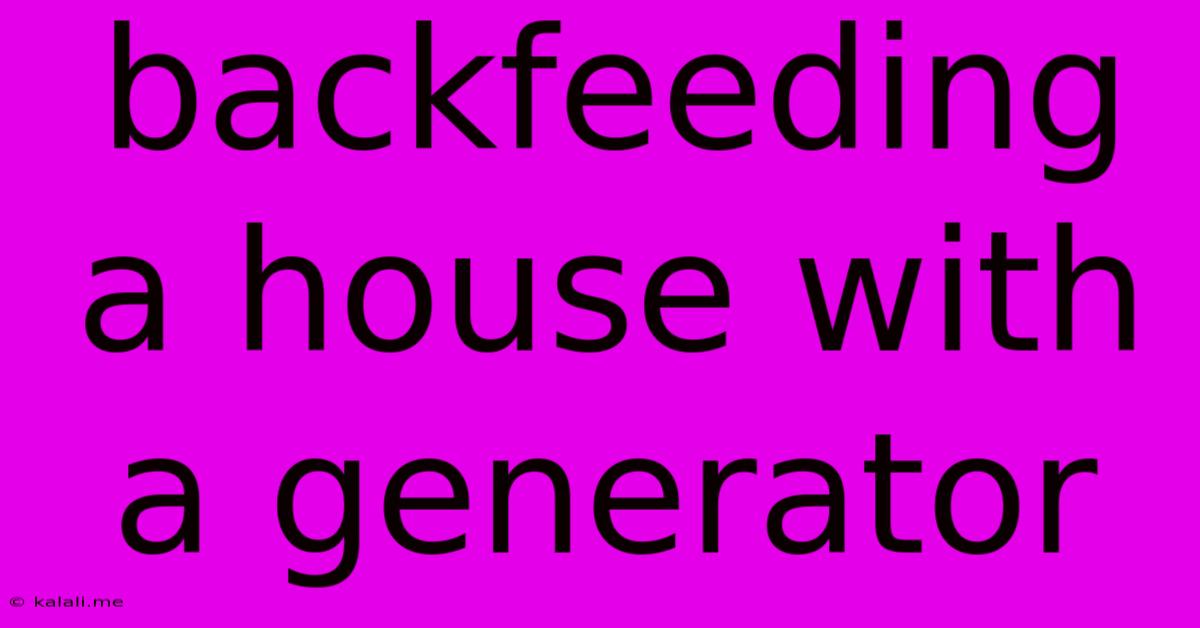Backfeeding A House With A Generator
Kalali
Jun 11, 2025 · 3 min read

Table of Contents
Backfeeding Your House with a Generator: A Comprehensive Guide
Meta Description: Learn the safe and effective methods for backfeeding your home with a generator during a power outage. This guide covers crucial safety precautions, different connection types, and essential considerations for a successful setup.
Power outages can be disruptive, but a properly installed generator can provide a lifeline. One method of powering your home during an outage is backfeeding, which involves connecting your generator to your home's electrical system. However, backfeeding a house with a generator is inherently dangerous and should only be undertaken by qualified electricians. This guide provides information for educational purposes only and does not constitute professional advice. Always prioritize safety and consult with a licensed electrician before attempting any electrical work.
Understanding Backfeeding
Backfeeding refers to connecting a generator directly to your home's electrical panel. This bypasses the utility company's power supply, allowing the generator to become the primary power source for your home. It's important to distinguish this from interconnecting, where a transfer switch safely isolates your home's wiring from the utility grid. Backfeeding is generally considered less safe than using a transfer switch.
Safety Precautions: The Most Crucial Aspect
Before even considering backfeeding, understand the severe risks involved:
- Electrocution: Working with live electrical circuits is extremely dangerous and can be fatal.
- Fire Hazard: Incorrect wiring or overloaded circuits can easily start a fire.
- Carbon Monoxide Poisoning: Improper generator ventilation can lead to deadly carbon monoxide buildup inside your home.
- Damage to Appliances: Backfeeding can damage sensitive electronics if not done correctly.
Never attempt backfeeding without extensive knowledge of electrical systems and safety protocols. Improper backfeeding can void your homeowner's insurance and cause significant damage.
Methods of Backfeeding (For Informational Purposes Only)
While we strongly discourage backfeeding, understanding the common methods is crucial for understanding the inherent risks:
- Direct Connection to the Panel: This involves connecting the generator directly to the breaker panel, usually through a manual transfer switch (though this is often considered a form of backfeeding and is inherently dangerous). This is incredibly risky and should never be attempted without professional guidance.
- Using an Interlock Kit: Some older homes may have an interlock kit that allows for manual switching between the utility power and a generator. These kits provide a slightly improved level of safety compared to direct connection, but still carry significant risks.
Safer Alternatives: Transfer Switches and Interconnection
Instead of backfeeding, consider these significantly safer alternatives:
- Automatic Transfer Switch: This is the safest and most reliable method. An automatic transfer switch automatically switches your home's power source between the utility company and the generator during an outage. Installation by a qualified electrician is essential.
- Generator Interlock: This is a more common and safer alternative than backfeeding. It requires a professional electrician to install and offers a safer method for transferring power from a generator to your home.
Choosing the Right Generator
Regardless of your chosen method (we strongly recommend a transfer switch), selecting the right generator is crucial:
- Size: The generator should have enough power to handle the essential appliances and circuits you need during an outage.
- Type: Standby generators are generally safer and more convenient than portable generators, especially for long-term power needs.
- Fuel Source: Consider the availability and cost of fuel when choosing your generator.
Conclusion: Prioritize Safety
While backfeeding your house with a generator might seem like a cost-effective solution, the inherent risks significantly outweigh the benefits. The potential for electrocution, fire, and carbon monoxide poisoning is simply too great. Investing in a professional installation of an automatic transfer switch or generator interlock is the safest and most responsible approach to ensuring your home has backup power during outages. Always consult with a qualified electrician before undertaking any electrical work.
Latest Posts
Latest Posts
-
Medical Surgical Nursing Test Questions And Answers Pdf
Jun 12, 2025
-
Which Of The Following Is System Software
Jun 12, 2025
-
Truth Table For 3 Input Nand Gate
Jun 12, 2025
-
What Are The Colours Of The Five Olympic Rings
Jun 12, 2025
-
Moment Of Inertia Of A Semicircle
Jun 12, 2025
Related Post
Thank you for visiting our website which covers about Backfeeding A House With A Generator . We hope the information provided has been useful to you. Feel free to contact us if you have any questions or need further assistance. See you next time and don't miss to bookmark.